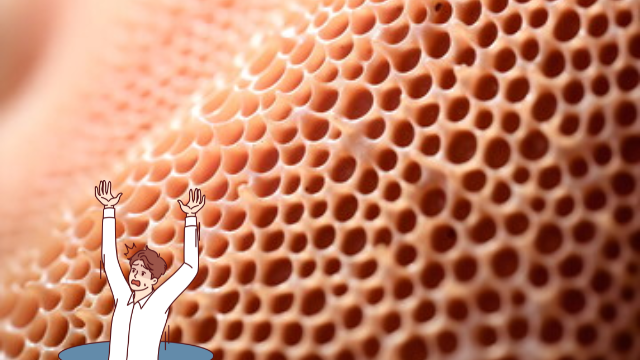Do you ever feel a sense of unease when you see clusters of small holes? You might be experiencing trypophobia, the fear of holes. In this article, we will explore the definition of trypophobia, common triggers, symptoms, and possible explanations for this fear. We will also discuss coping strategies and treatment options to help you manage trypophobia. Stay tuned to learn more about this intriguing phobia and how it can affect your daily life.
Definition of Trypophobia
Trypophobia is a specific phobia characterized by an intense fear of clusters of small holes. If you have trypophobia, you may experience a strong aversion or disgust when you see images or patterns of small holes, such as those found in honeycombs or lotus seed pods. The fear can also extend to objects or textures that resemble these hole patterns, like sponges or bubbles. It is important to note that trypophobia is not officially recognized as a mental disorder in the Diagnostic and Statistical Manual of Mental Disorders (DSM-5), which is the standard classification of mental disorders used by mental health professionals. However, it is still a valid and real fear that can cause significant distress and anxiety for those who have it. The exact cause of trypophobia is unknown, but it is believed to be related to a combination of genetic and environmental factors. Some theories suggest that it may be an evolutionary response to potential dangers, as some poisonous animals and plants have hole-like patterns. If you think you may have trypophobia, it is recommended to seek support from a mental health professional who can provide guidance and treatment options.
Common Triggers for Trypophobia
If you experience trypophobia, common triggers for this fear include seeing images or patterns of small holes, like those found in honeycombs or lotus seed pods. These triggers can vary from person to person, with some individuals being more sensitive to certain stimuli than others. To provide a clearer understanding of the common triggers for trypophobia, here is a table that outlines some examples:
| Trigger | Description |
|---|---|
| Honeycomb | The repetitive pattern of small holes, often found in beehives or honeycomb structures. |
| Lotus Seed Pods | The clusters of small holes or cavities commonly seen in the seed pods of the lotus flower. |
| Coral or Sponges | The porous texture of coral reefs or natural sponges, which can consist of numerous small openings. |
| Pumice Stone | The rough texture of pumice stone, characterized by its many tiny holes formed during volcanic activity. |
| Bubble Wrap | The plastic packaging material with rows of small air-filled bubbles, commonly used for protection or fun. |
| Cheese with Holes | Certain types of cheese, such as Swiss cheese, are known for their distinctive hole-filled appearance. |
It is important to note that these triggers may not elicit the same level of fear in everyone with trypophobia, and individual experiences may vary. If you have trypophobia, it may be helpful to avoid or limit exposure to these triggers to manage your fear.
Symptoms and Reactions to Holes
When exposed to triggers such as images or patterns of small holes, you may experience a range of symptoms and reactions if you have trypophobia. These symptoms can vary from person to person, but some common reactions include feelings of disgust, fear, and anxiety. You may also experience physical symptoms such as rapid heartbeat, sweating, trembling, and shortness of breath. The sight of holes may make you feel nauseous, and you may have an overwhelming urge to avoid looking at or being near them.
In addition to these immediate reactions, trypophobia can also have long-term effects on your mental health. The fear of holes may lead to the development of avoidance behaviors, where you actively try to stay away from situations or objects that trigger your phobia. This can have a significant impact on your daily life and may interfere with your ability to participate in certain activities or visit certain places.
If you suspect that you have trypophobia and it is affecting your daily life, it is important to seek help from a mental health professional. They can provide you with strategies to manage your symptoms and help you overcome your fear of holes. Remember, you are not alone, and there is support available to help you navigate this fear.
Possible Explanations for Trypophobia
One possible explanation for trypophobia is the association of hole patterns with harmful or dangerous organisms. Our brains are wired to detect and avoid potential threats in our environment, and hole patterns resembling the patterns found on venomous animals or diseased skin may trigger a fear response.
Evolutionarily speaking, our ancestors who were more cautious of these patterns had a higher chance of survival. This fear response may have been passed down through generations, leading to trypophobia in some individuals.
Another explanation could be the result of a learned response. If someone has had a traumatic experience involving hole patterns, their brain may associate similar patterns with that negative experience, resulting in a fear response. This could explain why trypophobia varies in severity among individuals.
It is important to note that not all individuals with trypophobia have had a traumatic experience or a direct encounter with harmful organisms. In some cases, the fear may be purely irrational and unrelated to any personal experiences.
Further research is needed to fully understand the underlying mechanisms behind trypophobia. By gaining a better understanding of this condition, we can develop effective treatments and support for those who suffer from it.
Coping Strategies and Treatment Options for Trypophobia
To manage trypophobia, you can explore various coping strategies and treatment options that can help alleviate your fear. Here are some options to consider:
- Cognitive-behavioral therapy (CBT): This type of therapy focuses on identifying and changing negative thought patterns and behaviors associated with trypophobia. It can help you develop coping mechanisms and gradually face your fear.
- Exposure therapy: This form of therapy involves gradually exposing yourself to images or situations that trigger your trypophobia. Under the guidance of a therapist, you can learn to manage your anxiety and fear response over time.
- Relaxation techniques: Practicing relaxation techniques such as deep breathing, meditation, or progressive muscle relaxation can help you calm your mind and body when faced with triggers.
- Support groups: Joining a support group or online community of individuals with trypophobia can provide you with a safe space to share experiences, seek advice, and receive support from others who understand what you’re going through.
Read this next:

